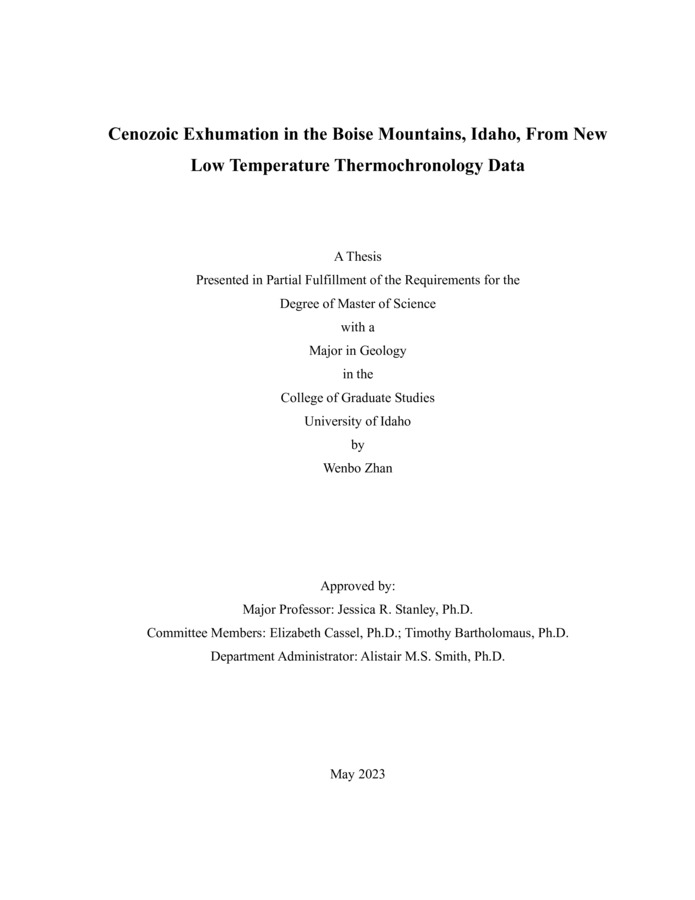Cenozoic Exhumation in the Boise Mountains, Idaho, From New Low Temperature Thermochronology Data
Zhan, Wenbo. (2023-05). Cenozoic Exhumation in the Boise Mountains, Idaho, From New Low Temperature Thermochronology Data. Theses and Dissertations Collection, University of Idaho Library Digital Collections. https://www.lib.uidaho.edu/digital/etd/items/zhan_idaho_0089n_12605.html
- Title:
- Cenozoic Exhumation in the Boise Mountains, Idaho, From New Low Temperature Thermochronology Data
- Author:
- Zhan, Wenbo
- Date:
- 2023-05
- Keywords:
- Idaho batholith landscape evolution North American Cordillera tectonics thermochronology Yellowstone hotspot
- Program:
- Geography & Geological Science
- Subject Category:
- Geology; Geochemistry
- Abstract:
-
The modern topography of the Atlanta lobe of the Idaho batholith in the North American Cordillera has been identified as a dissected plateau. The plateau was suggested to exist since Late Cretaceous, while the dissection was advocated to take place since Late Miocene, associated with unusual regional topographic rejuvenation in a post-orogenic extensional tectonic setting far away from the convergent plate boundary. However, the previous evidence supporting the timing and mechanism of the dissection is limited. Spatial variability of multiple aspects exists within the Atlanta lobe. Previous studies identified a Miocene cooling and exhumation signal in the southern Atlanta lobe, but the spatial extent of this signal is unknown. To further reconstruct the exhumation history of the region and investigate the mechanisms that cause the internal variability of the Atlanta lobe, we investigate the area using low temperature thermochronology. We sampled Late Cretaceous and Miocene aged granitoid bedrock along the South Fork Payette River (SFPR) and the Middle Fork Boise River (MFBR) in the Boise Mountains, resulting in three vertical and two horizontal sample transects, a total of 21 new apatite (U-Th)/He (AHe) sample dates and 2 new apatite fission track (AFT) dates from previous samples. The AHe dates range from 29.9 ± 3.1 Ma to 3.9 ± 0.8 Ma, and most cooling dates are Miocene to Pliocene. The two AFT dates are 37.89 ± 4.6 Ma and 40.7 ± 4.72 Ma. The thermal history inverse models from the vertical transects show a two-stage cooling during Eocene-Oligocene and Late Miocene–Pliocene, supporting the Late Miocene incision. The pattern of cooling dates along the river profiles from the horizontal transects suggests that the incision of modern SFPR and MFBR occurred after the major Late Miocene cooling period, and has been disrupted by faults. Combining our thermochronology data with other geological evidence, we propose a tectonic model to explain the exhumation history and the variability inside the Atlanta lobe. We suggest the Eocene exhumation was due to extension from overthickened crust, thermal-dynamic uplift, and potentially delamination under the Atlanta lobe due to the influx of hot asthenosphere. The Miocene exhumation could have been driven by thermal-dynamic uplift and/or delamination under the Boise Mountains triggered by the nearby Yellowstone Hotspot. The incision of the SFPR and MFBR was likely enhanced by base level drop due to the draining of the Paleo-Lake Idaho, and disrupted by activity on local Basin and Range faults.
- Description:
- masters, M.S., Geography & Geological Science -- University of Idaho - College of Graduate Studies, 2023-05
- Major Professor:
- Stanley, Jessica
- Committee:
- Cassel, Elizabeth; Bartholomaus, Timothy; Smith, Alistair
- Defense Date:
- 2023-05
- Identifier:
- Zhan_idaho_0089N_12605
- Type:
- Text
- Format Original:
- Format:
- application/pdf
- Rights:
- In Copyright - Educational Use Permitted. For more information, please contact University of Idaho Library Special Collections and Archives Department at libspec@uidaho.edu.
- Standardized Rights:
- http://rightsstatements.org/vocab/InC-EDU/1.0/

